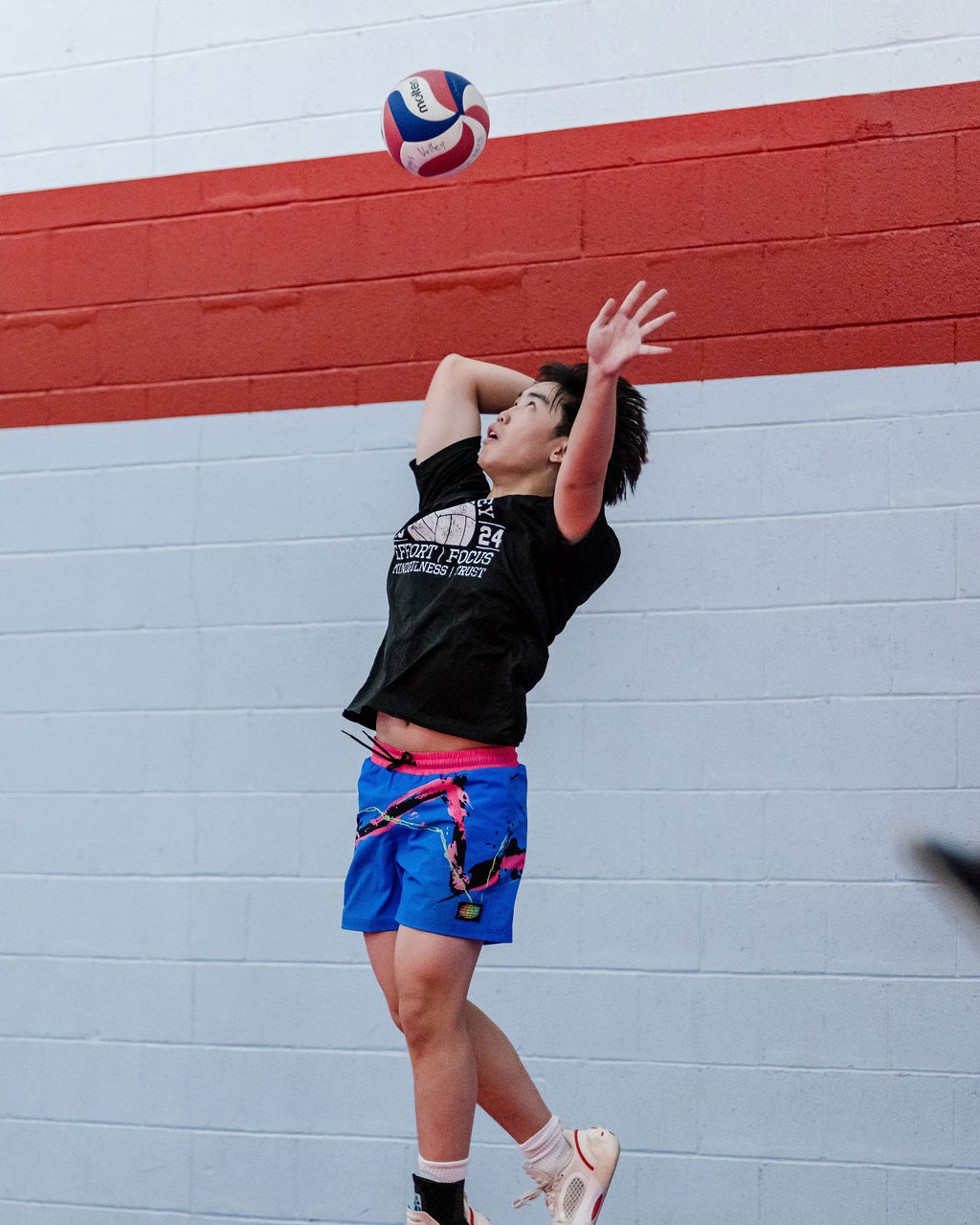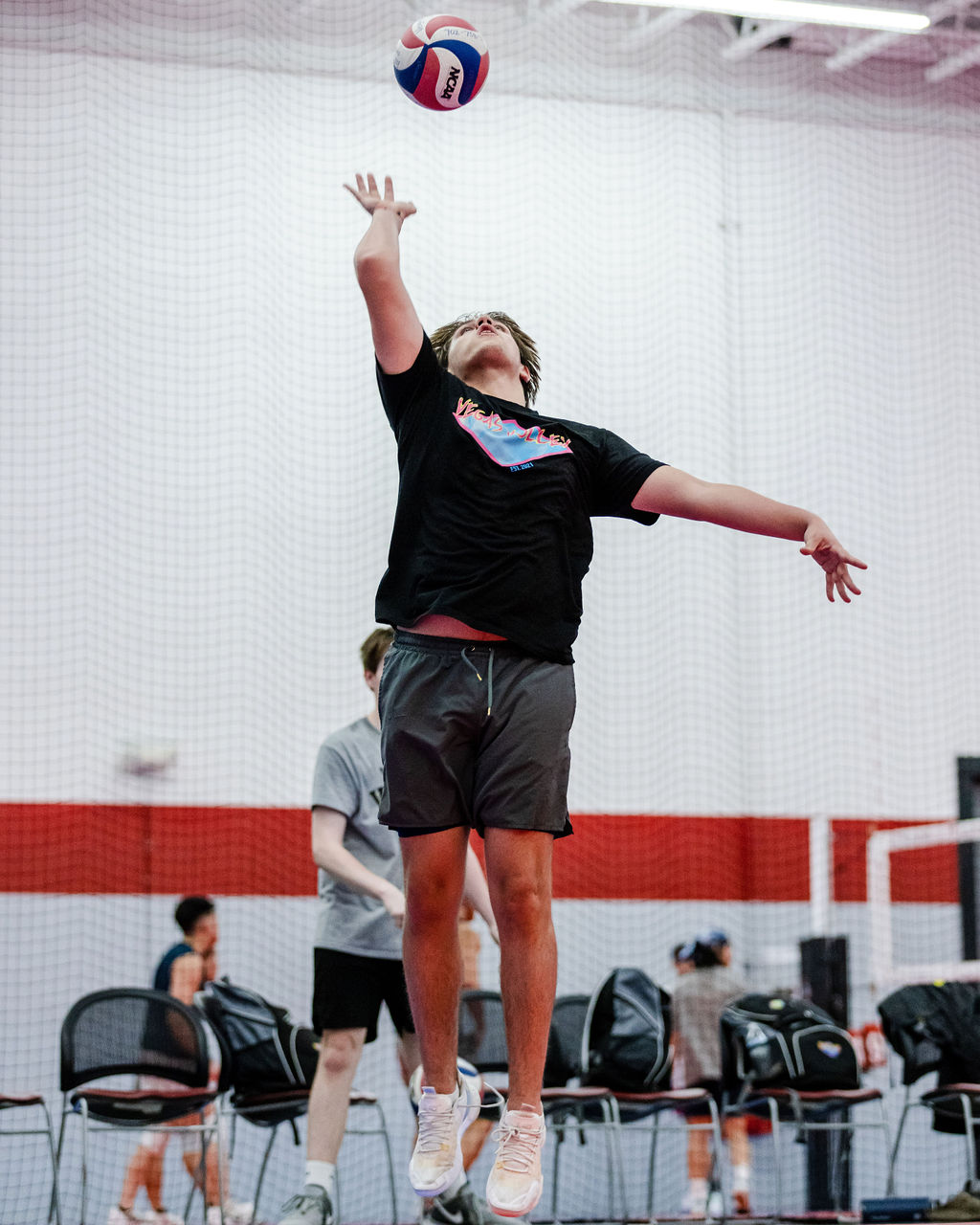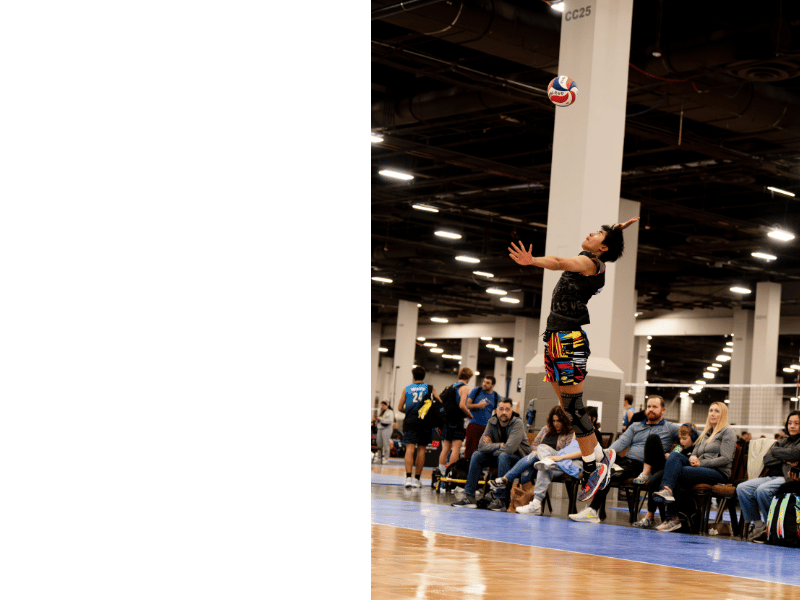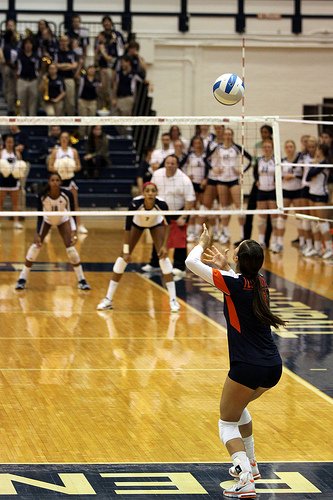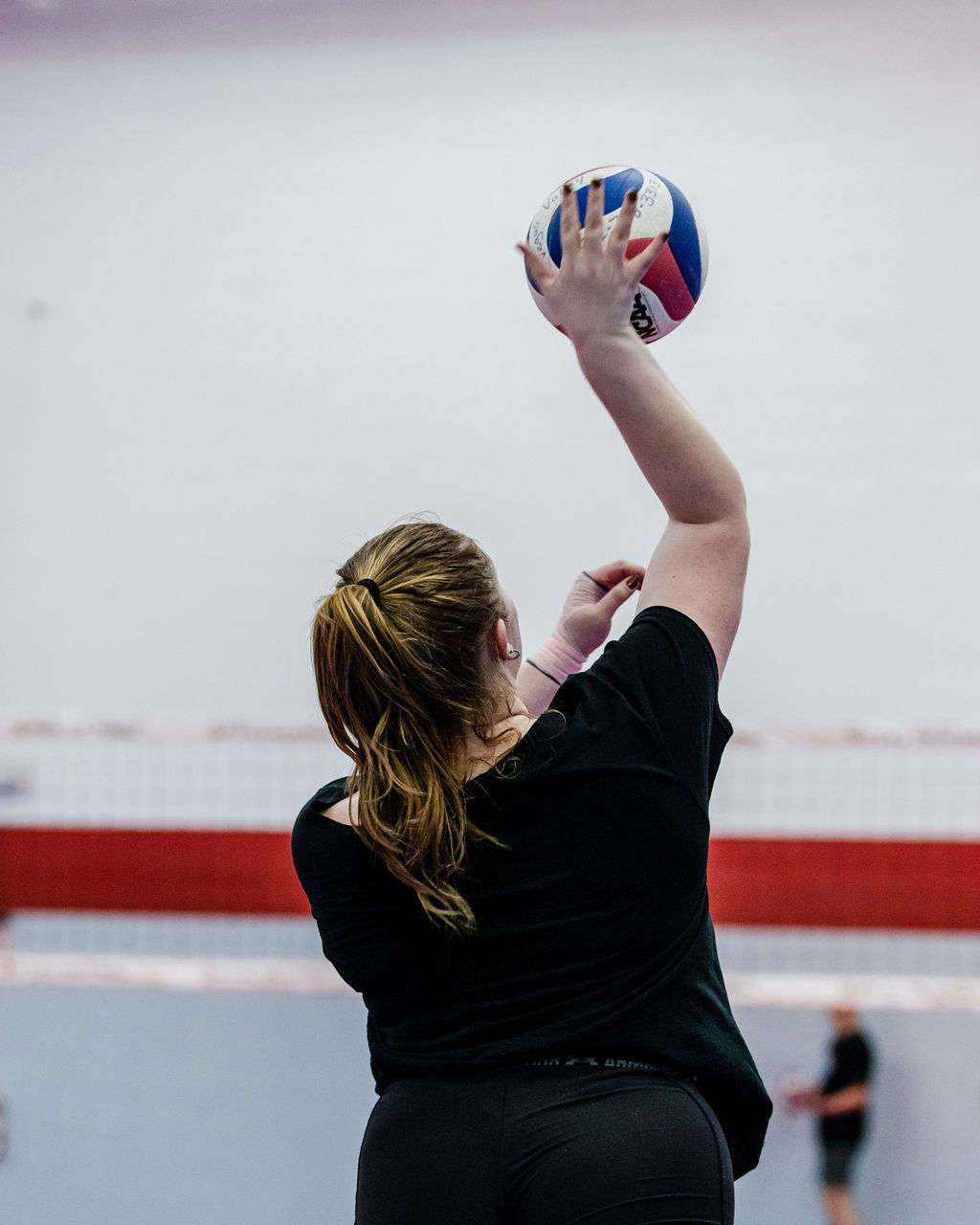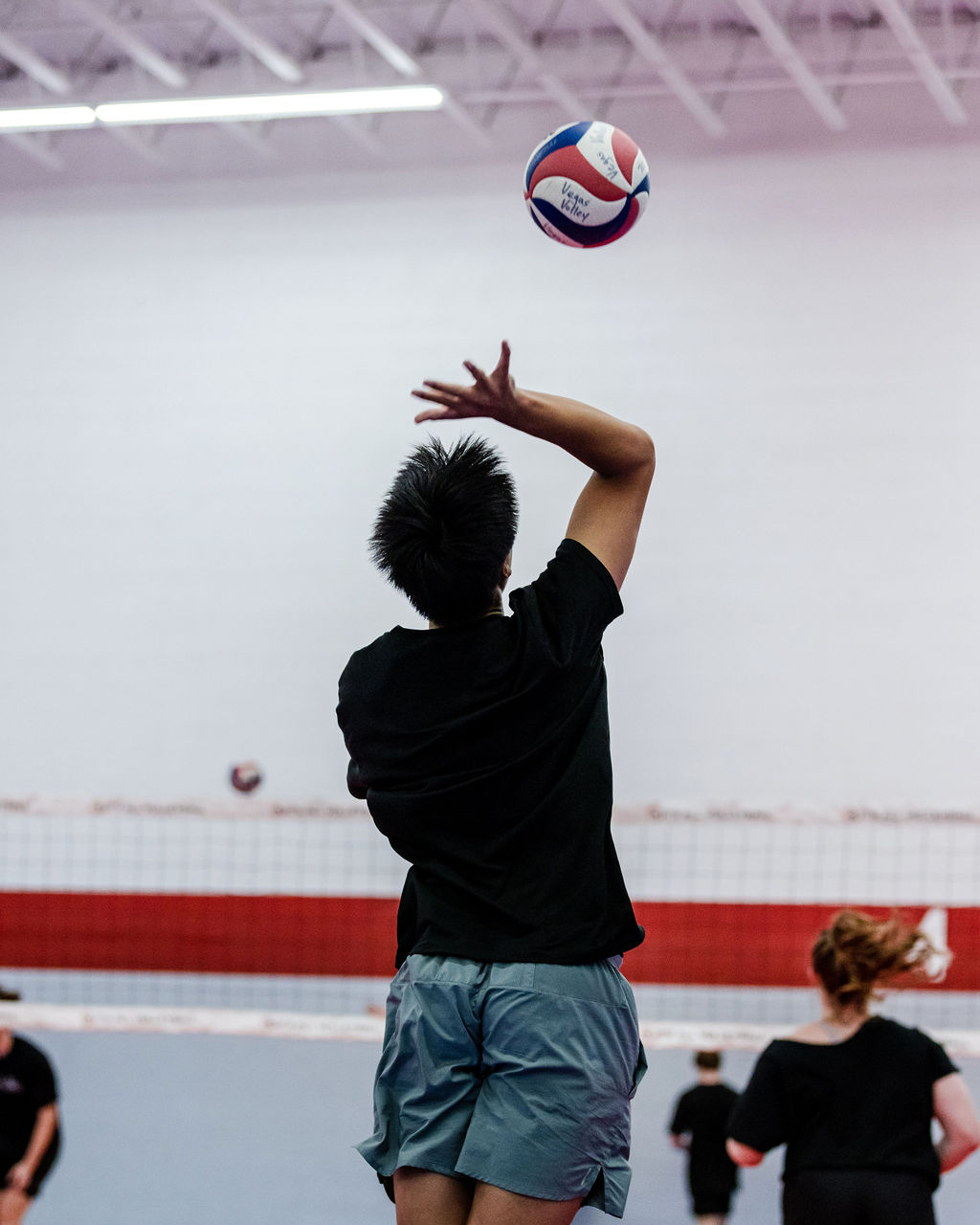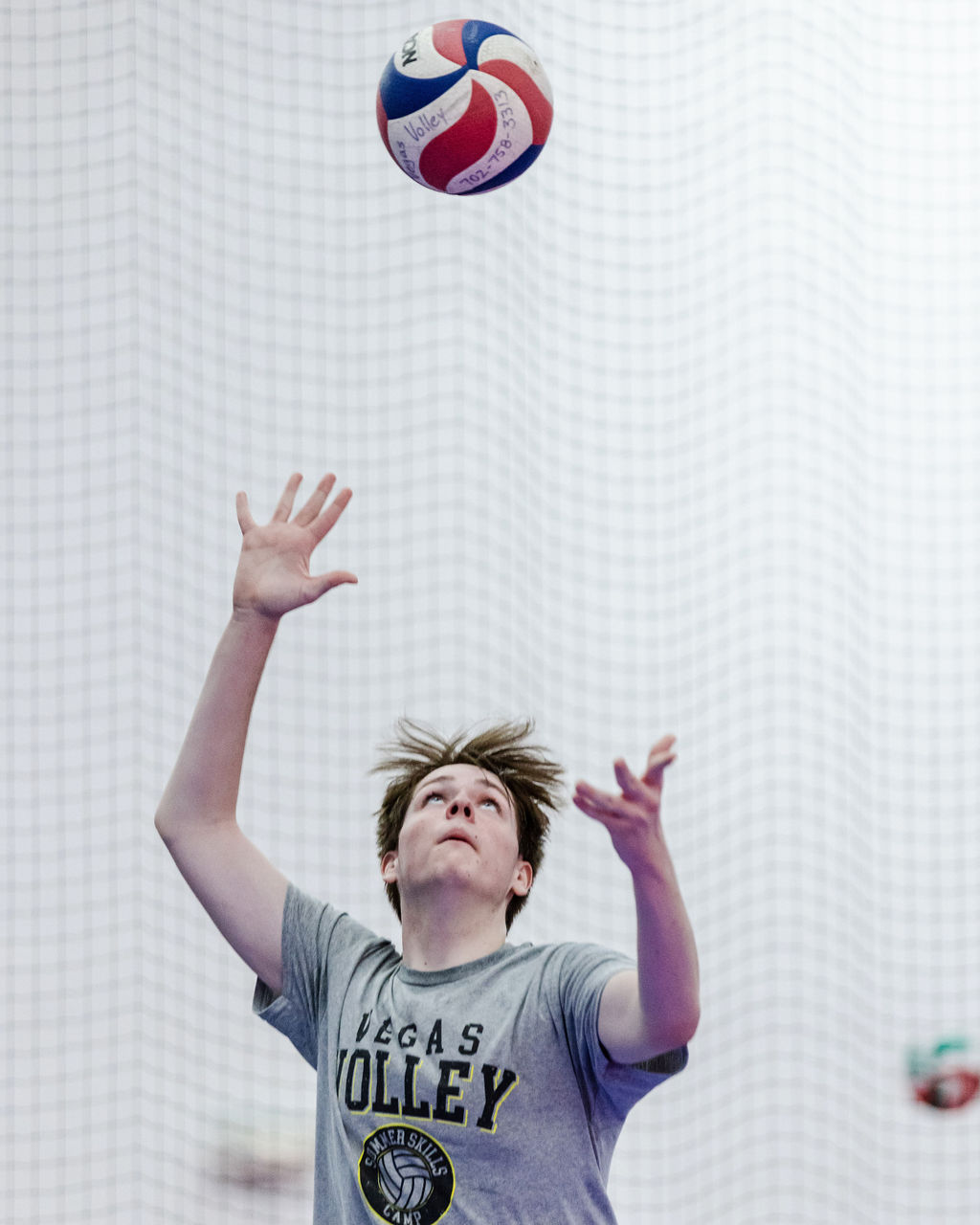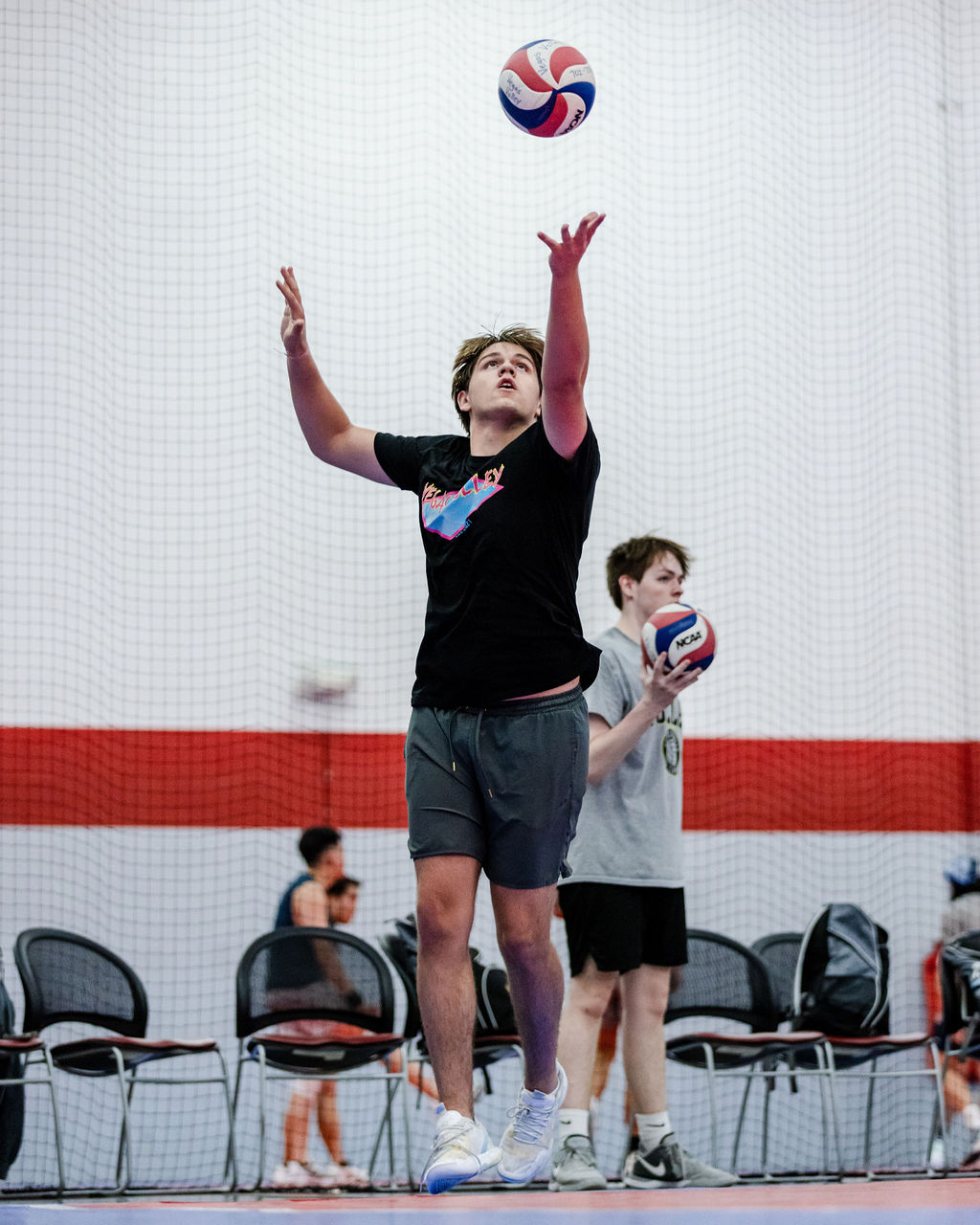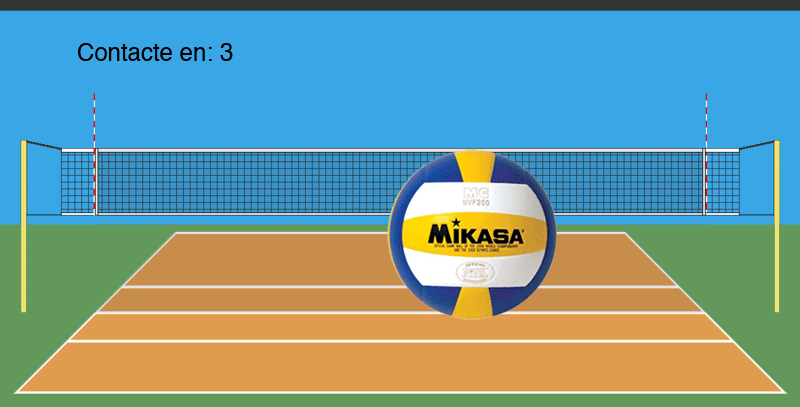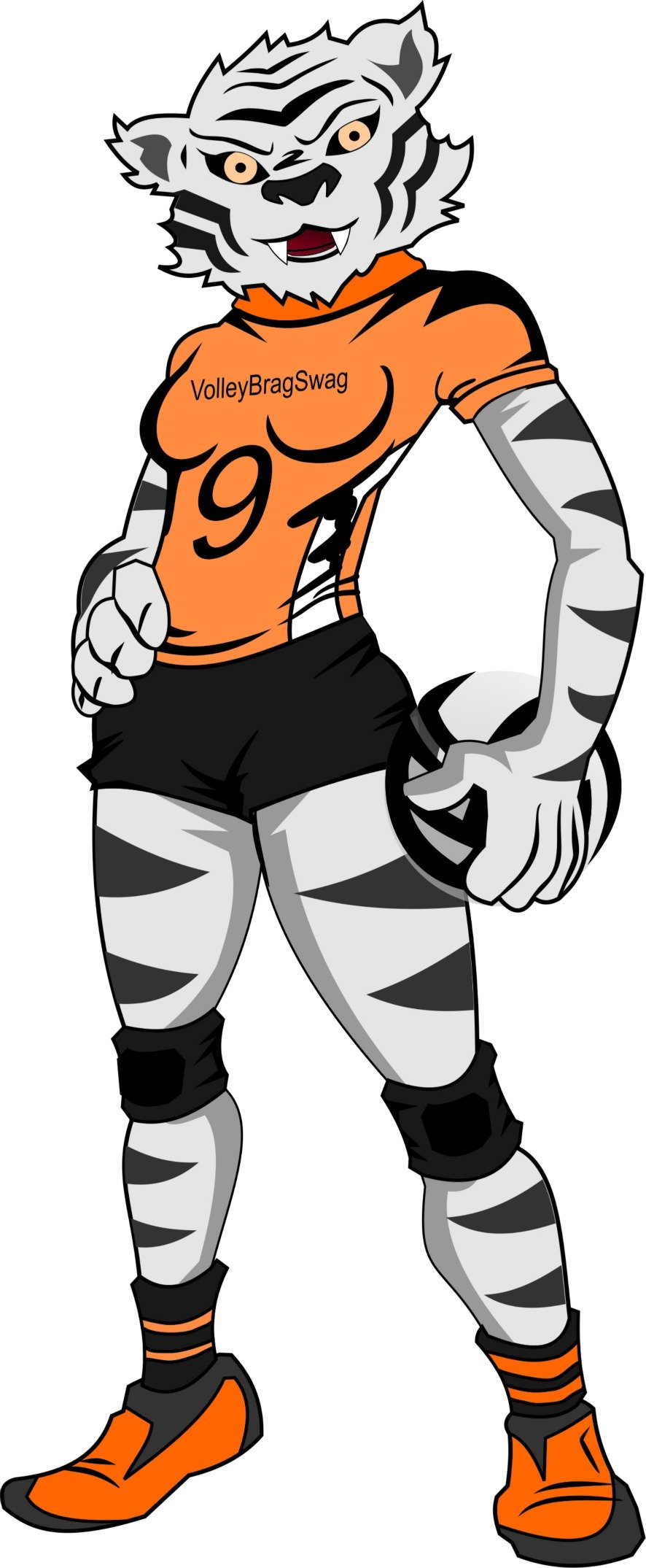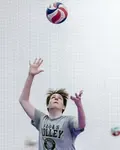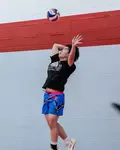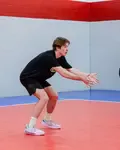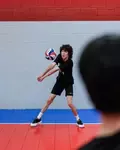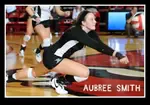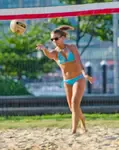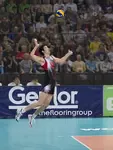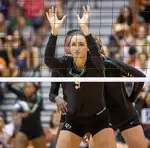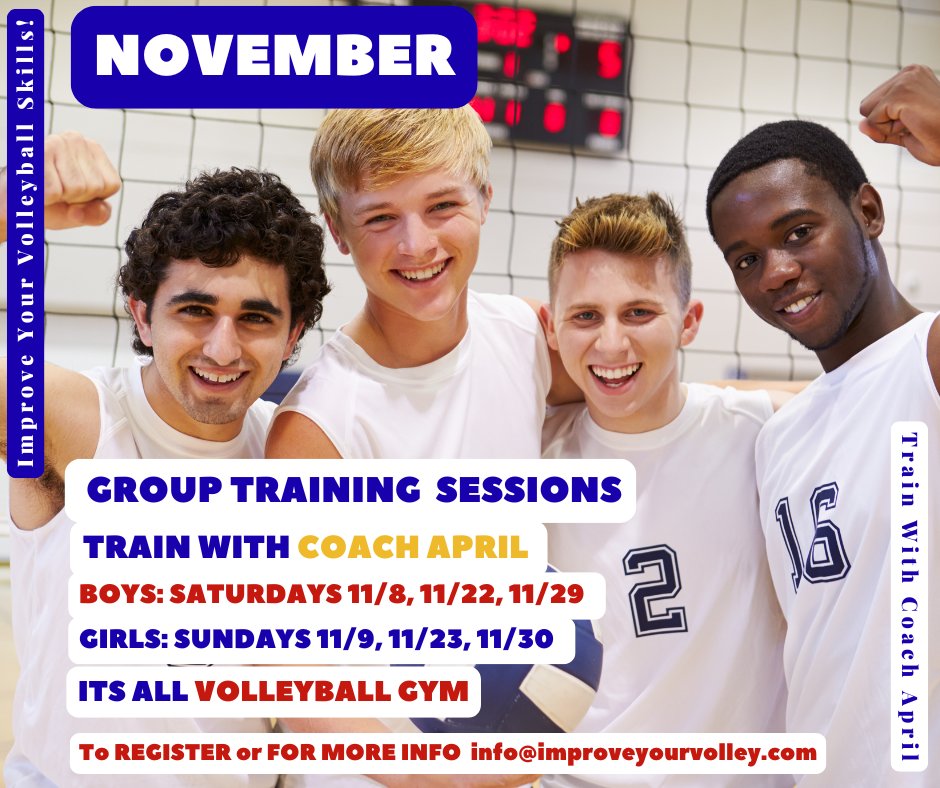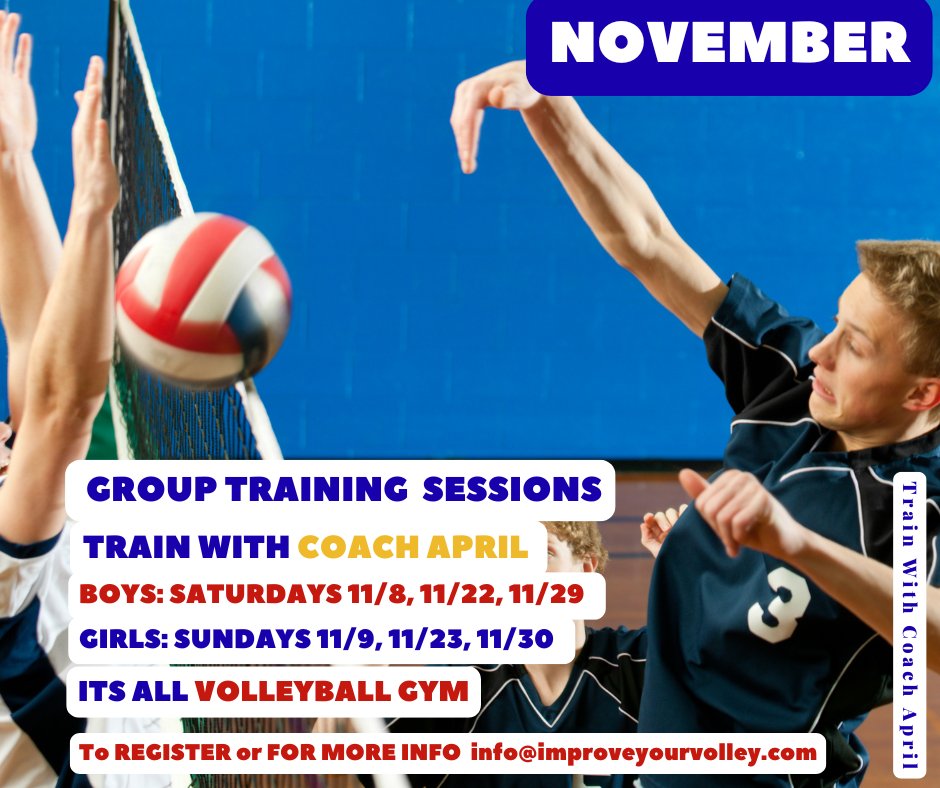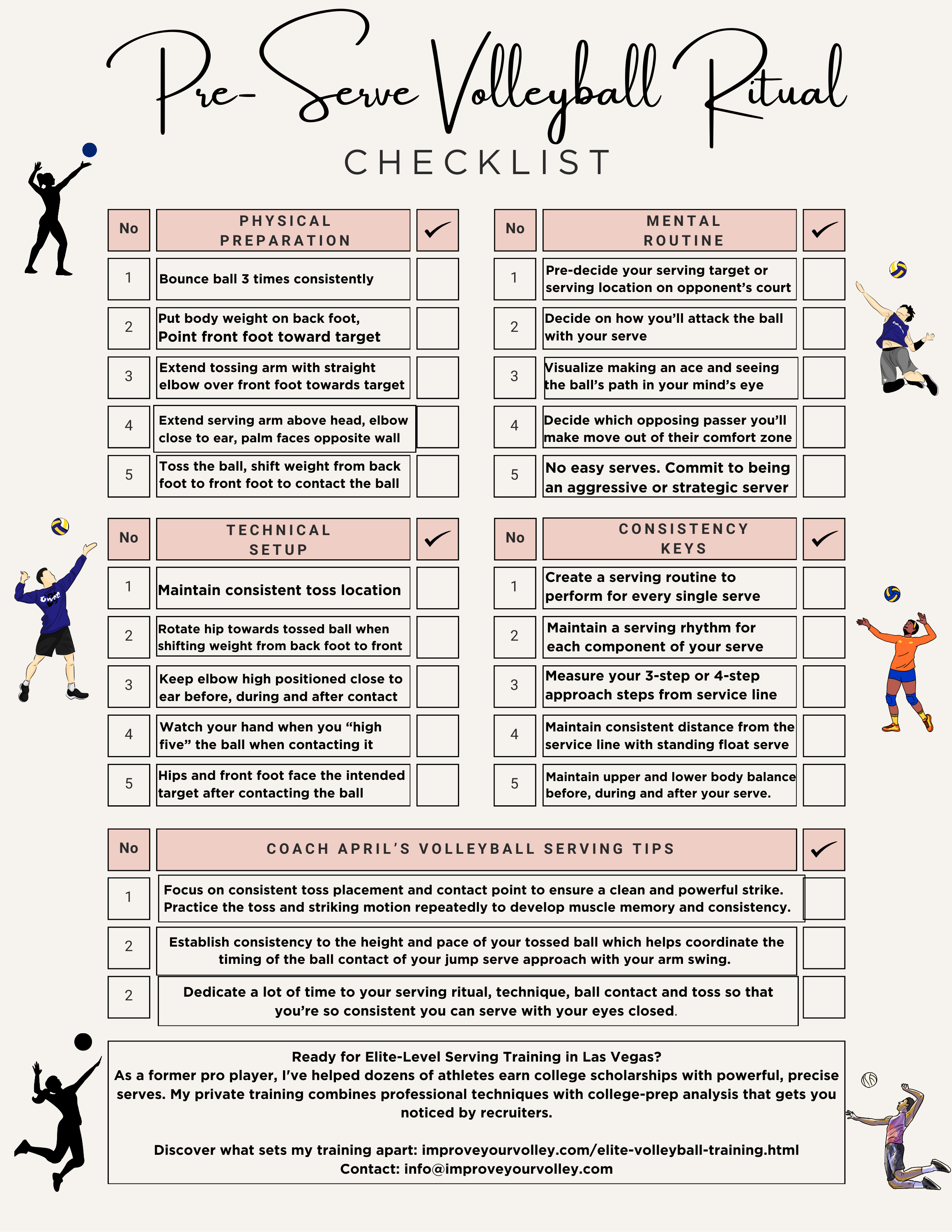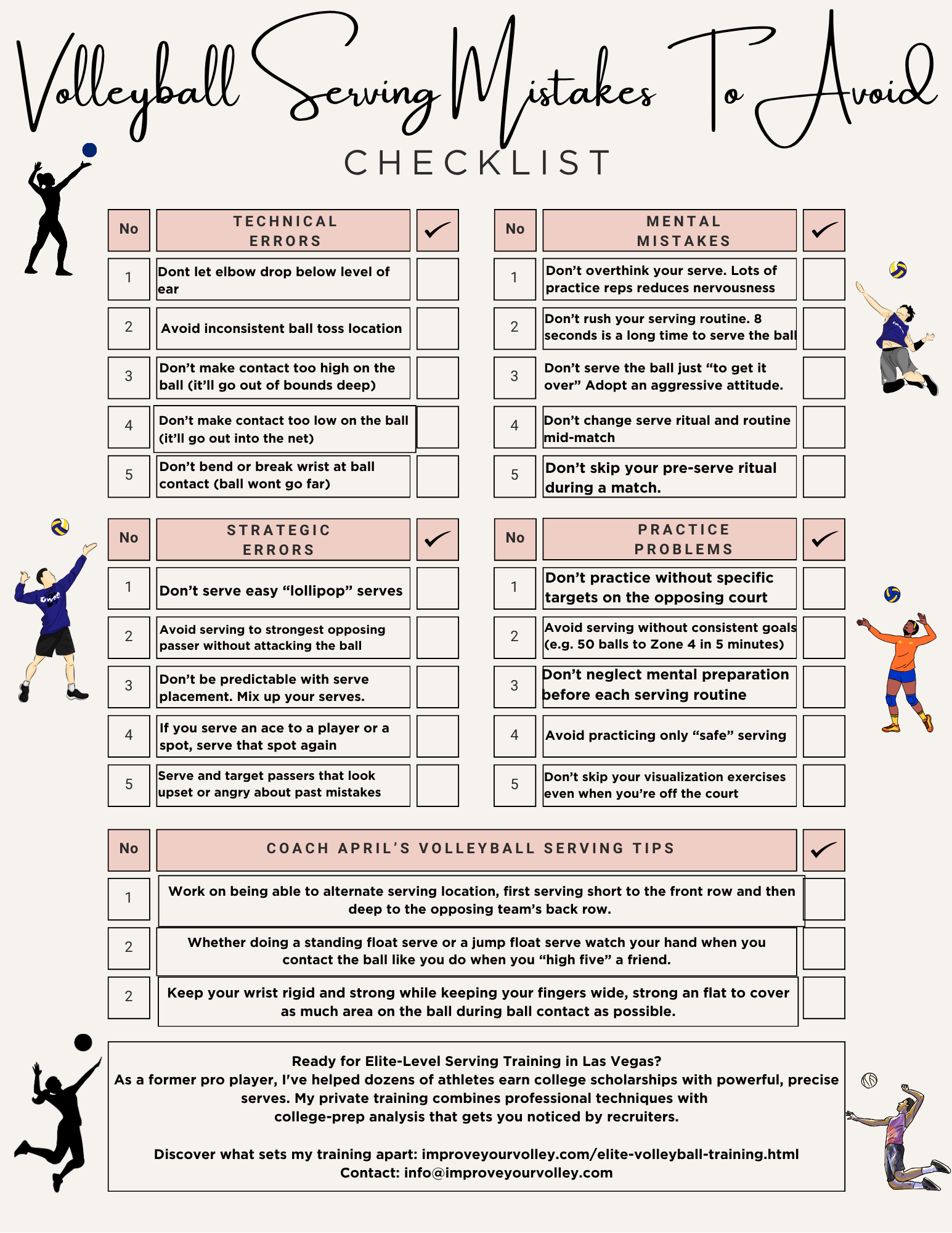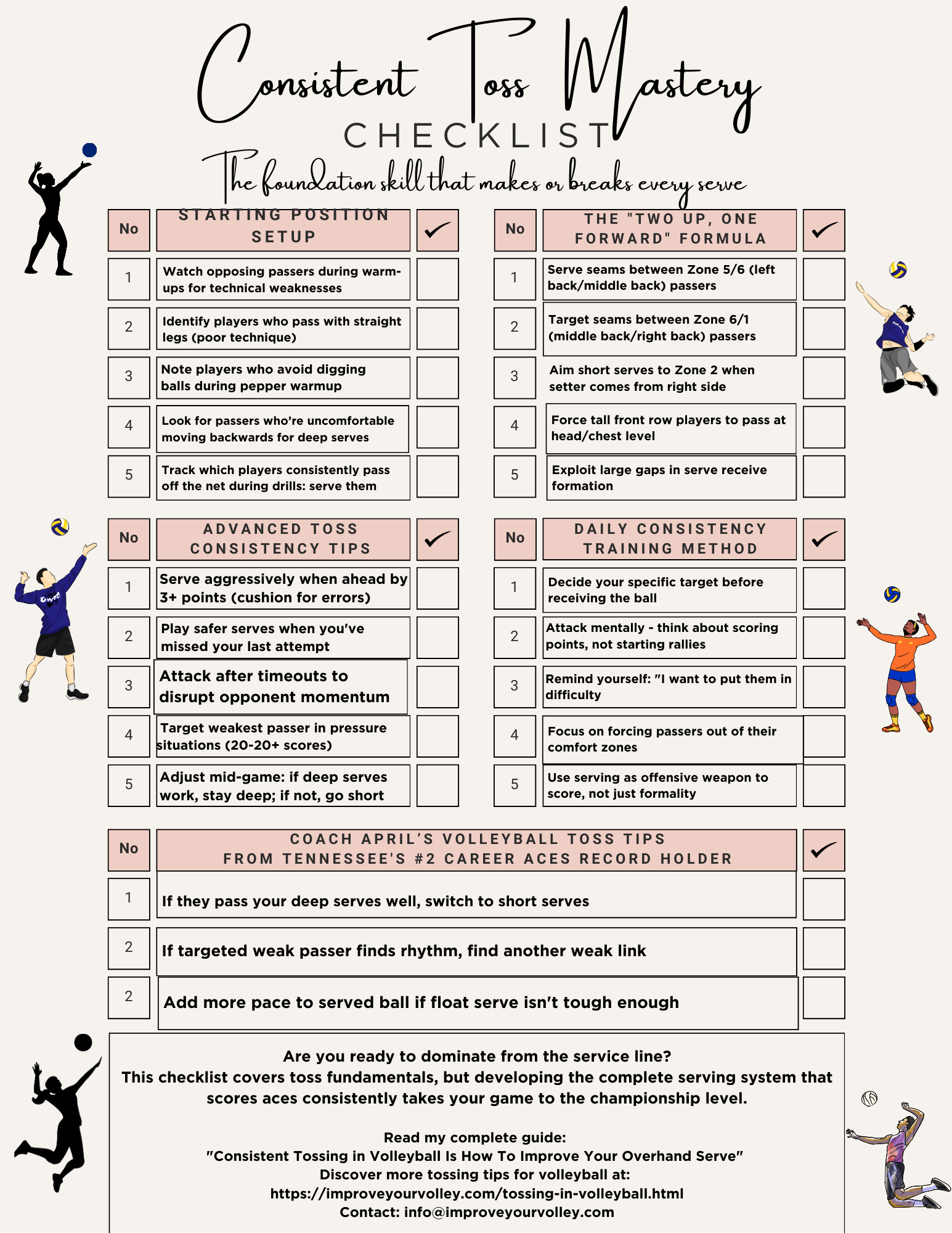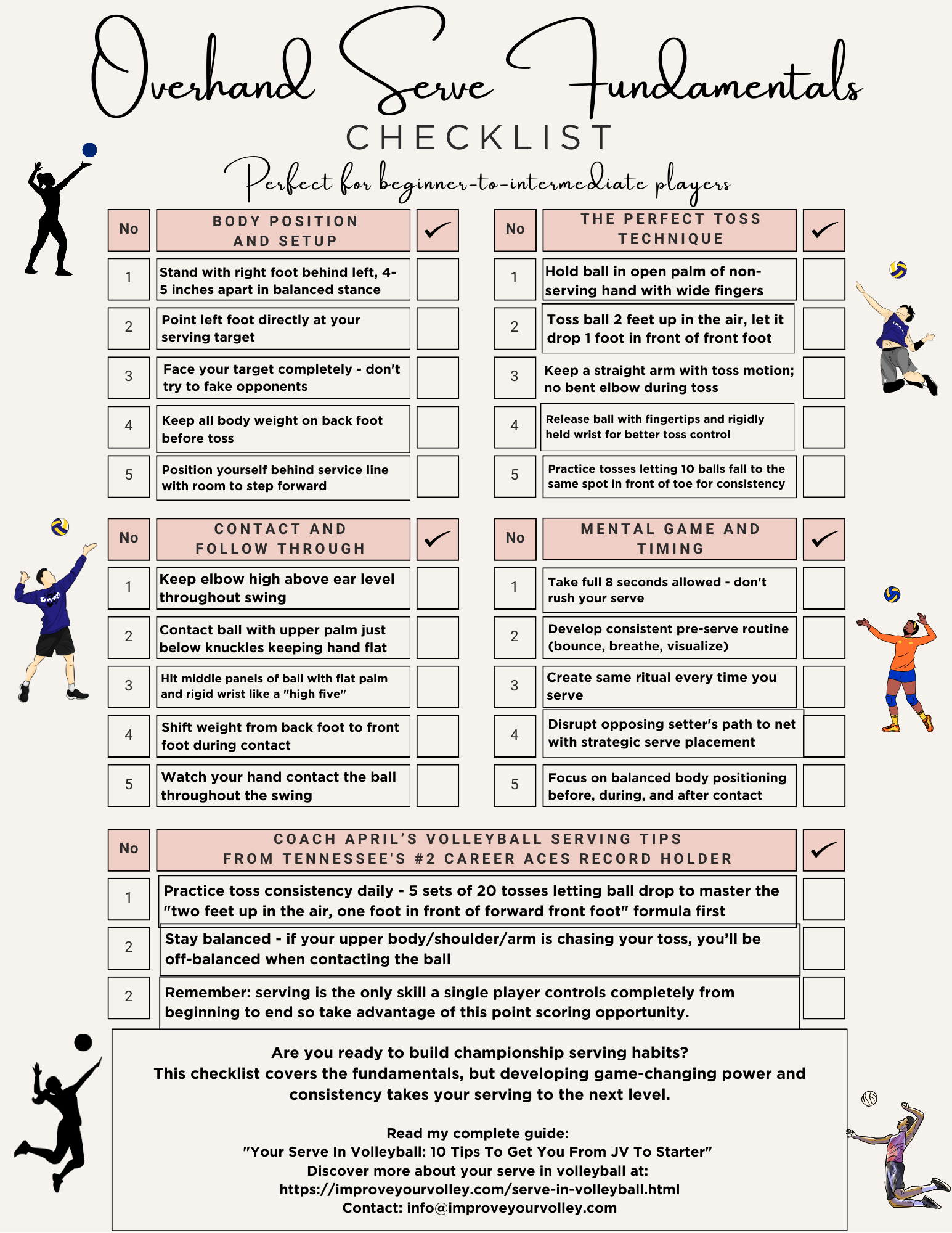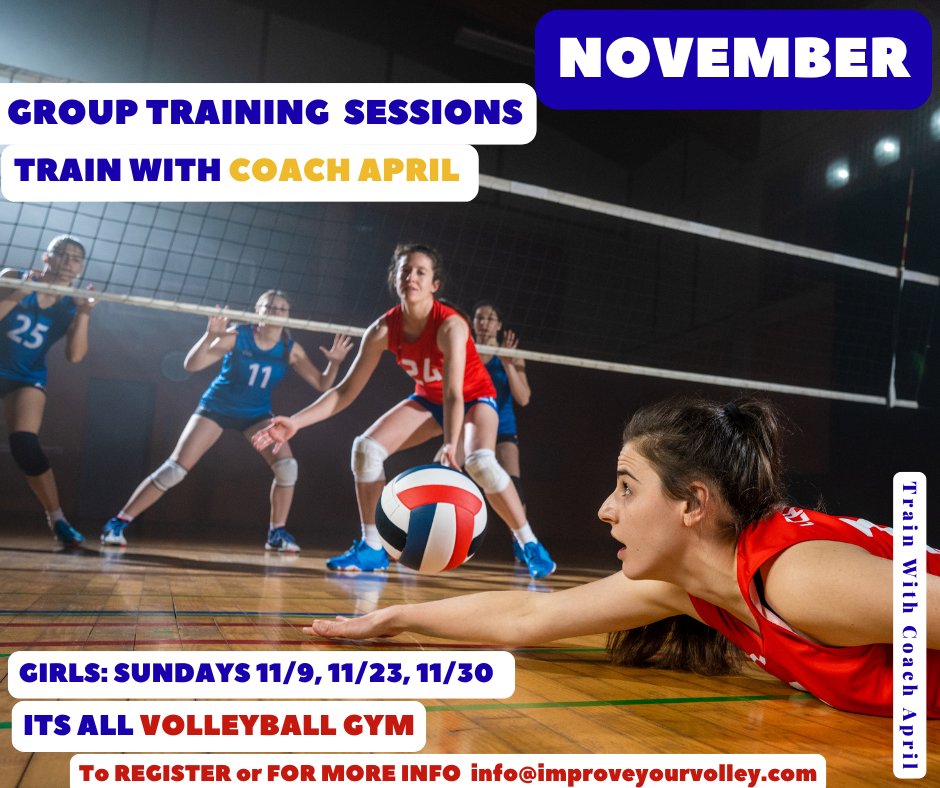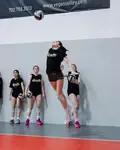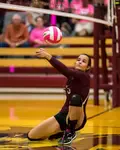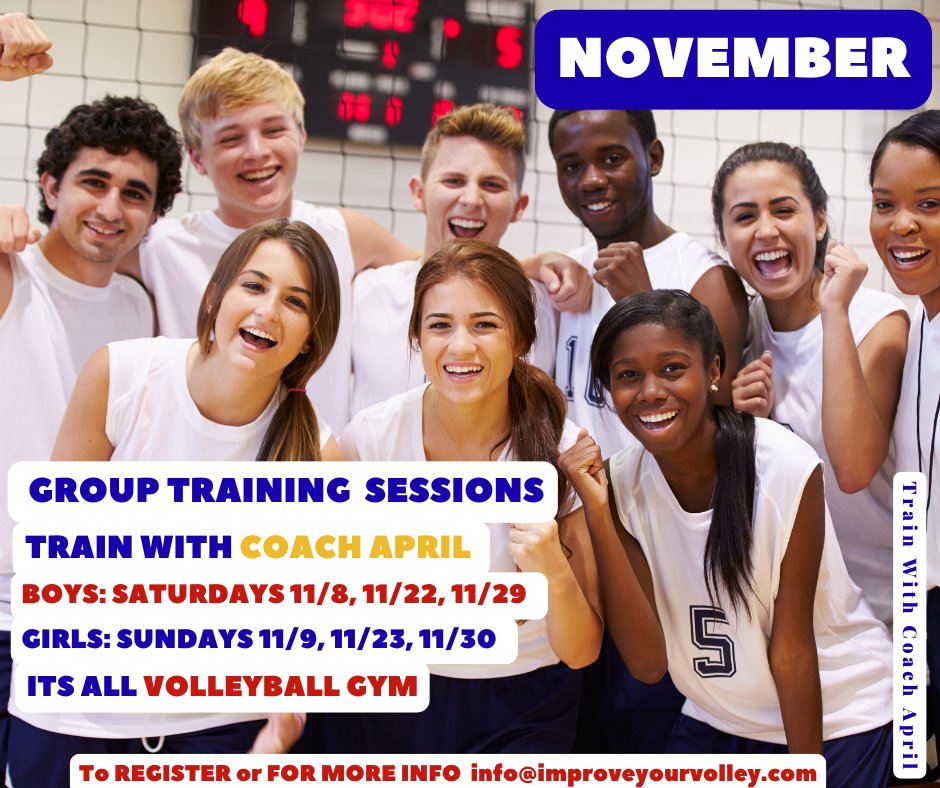 NOVEMBER Group Training with Coach April
Registration is NOW open for Group Training Sessions with me Coach April For BOYS on SATURDAYS 11/8, 11/22, 11/29
For GIRLS on SUNDAYS 11/9, 11/23, 11/30
From 10-11am at the Its All Volleyball gym.
Email: info@improveyourvolley.com to register or for more information
NOVEMBER Group Training with Coach April
Registration is NOW open for Group Training Sessions with me Coach April For BOYS on SATURDAYS 11/8, 11/22, 11/29
For GIRLS on SUNDAYS 11/9, 11/23, 11/30
From 10-11am at the Its All Volleyball gym.
Email: info@improveyourvolley.com to register or for more information- Improve Your Volleyball with Coach April
- Basic Volleyball Skills for Beginners
- What Is A Volleyball Serve
What Is A Volleyball Serve? Learn The Basics and Advanced Techniques
Are you wondering what is a volleyball serve? It's your first chance to score. Learn float, jump, and topspin serves that transform beginners into ace machines.
If you could score points without needing anyone else's help, wouldn't that be valuable?
That's exactly what serving offers.
What is a volleyball serve?
Most players think it's just the way you start a rally after the referee blows the whistle.
But here's what they're missing: the serve is your first and best opportunity to score a point, and it's the only skill in volleyball where you have complete control from start to finish.
Think about it - in every other volleyball skill, you're reacting to someone else.
- Passing depends on how the opponent serves.
- Hitting depends on the setter's delivery.
- Blocking depends on the opposing team's attack.
But serving?
That's 100% you. No teammates needed, no opponents interfering - just you and your ability to put the ball exactly where you want it.
With my many years of coaching volleyball in Las Vegas, I've watched players transform their entire game by understanding what a volleyball serve really is: a strategic weapon, not just a formality.
Ready to discover why the serve might be the most important skill you'll ever develop?
What is a Volleyball Serve:
More Than Just Starting Play
If you could score points without needing anyone else's help, wouldn't that be valuable?
That's exactly what serving offers.
The volleyball serve is your first opportunity to score a point and it's the one individual skill in volleyball that you have complete control of.
Addi getting 100 overhand serve reps in on Super Bowl Sunday working on her standing float serve down the line.
Focusing on starting with hips open to the wall to her right, a consistent toss and a smooth arm swing when contacting the ball with the middle of her hand to the middle of the ball.
Addi works on her jump float serve toss consistency while aiming for a deep line serve to Zone 5.
From the moment
- you pick up the ball behind the service line,
- to once it leaves your hands for the toss after the ref blows the whistle
you literally have the ability to score points for your team, if you use the correct volleyball serving technique.
The serve is often the first offensive skill a player usually learns.
If you can't serve the ball, you can't play the game, since throwing the ball over the net isn't allowed.
Syd works on improving her standing float serve during private training with me.
Now let's explore the three types of serves that can transform your game...
The Three Types of Volleyball Serves Every Player Should Know
What Is A Volleyball Serve?
Ever notice how the best servers seem to use multiple options?
That's because they've mastered these three serve types...
There are various types of volleyball serves that players can utilize.
Here are a few commonly used serve types:
Volleyball Serves - The Float Serve
When you look at my players you'll see (or should see) that all of them have the same serving form and technique. We work hard on -
- keeping the elbow close to the ear
- watching their hand when they contact the ball
- watch how their hips are facing where they want to serve the ball (we were working on serving line to zone 5)
- all of them are or will contact the ball at the same spot on the ball, so the upper part of the palm just below the knuckles contact the middle panels of the ball
- working on a consistent toss on every serve so I know exactly where to contact the ball
Hold the ball with a light grip in your non serving hand which will be your tossing hand, almost like you're cradling it.
Toss the ball two feet up in the air and one foot in front of your front foot which is pointed in the direction of where you want the ball to be served.
The key is to keep your toss so consistent, that if you toss the ball ten times in a row and let it fall to the ground, it goes up the same height and comes down in the same spot every single time.
As you swing your arm forward, make contact with the middle or lower part of the ball using a firm, flat hand.
Rather than adding topspin or backspin, focus on a clean, direct hit.
The primary benefit of the float serve is its ability to disrupt the opposing team's reception.
This can make it challenging for passers to read the trajectory and adjust their positioning accordingly.
What Is A Volleyball Serve?
The Jump Serve
Are you a tough volleyball server?
As a tough volleyball server, your job is to be comfortable serving anywhere and anyone from behind the service line with pace and precision in order to score points.
When you do your volleyball drills for serving practice you want to do tons of reps to every single one of the six positions on the court.
You want to be able to hit those targets from anywhere behind the service line.
Targets to aim for during your volleyball drills for serving:
-serve seams
-serves the sidelines
-serve outside hitters deep in the court
Some players think that being a tough volleyball server means you need to really be sneaky and try and fake out the serve receive by not showing where you are going to serve.
On the contrary I say...let everybody know where you are going to serve.
Face Your Target.
The jump serve is a dynamic and powerful serving technique that can give you a strategic advantage on the court.
To execute a jump serve effectively, start by standing behind the service line and take a few steps back for your approach.
My College Breakfast Club training group working on jump float serve skills specifically hand to ball and toss consistency.
step - toss - step close - launch yourself in the air
As you reach the peak of your approach, jump off both feet, extending your hitting arm back and swinging it forward forcefully.
The primary advantage of the jump serve is the added power and velocity it can generate so once the ball passes over the net it spins to the ground quickly.
With a well-executed jump serve, you can put significant pressure on the opposing team's serve reception, making it difficult for them to control the ball and initiate a strong offensive play.
To maximize the effectiveness of your jump serve, consider the following tips:
1. Timing
Focus on timing your approach jump to ensure you contact the ball at the highest point of your jump.
Practice the timing and coordination of your steps, arm swing, and jump reach to achieve a seamless motion with no pauses or hesitations in your approach to the ball.
2. Generating Height
Work on developing explosive leg power to achieve the maximum height in your jump.
I like to tell my clients to attack the floor with the last two steps of your approach in order to launch yourself higher in the air using your leg muscles to drive upward forcefully to gain additional height during the serve.
3. Generating Velocity
To generate velocity, focus on a strong back swing with both arms and quickly and aggressively swing both arms forward before pulling the elbow of the serving arm back keeping the elbow close to your ear while turning the palm of the hand towards the ball before you make contact with the ball.
Use the full range of motion in your hitting shoulder and snap your wrist to add speed to the serve.
4. Practice and Consistency
Like any skill, the jump serve requires practice and consistency to refine your technique and develop accuracy and control.
Set aside practice sessions to work on your jump serve and strive for repetition and refining your technique.
By mastering the mechanics of the jump serve and incorporating it into your game strategy, you can become a formidable server and disrupt the opposing team's serve reception, giving your team a significant advantage.
Volleyball Serves
Topspin Serve
The topspin serve is a powerful serving technique that can put significant pressure on the opposing team's reception.
It involves imparting topspin rotation on the ball, resulting in a downward trajectory when the ball crosses the net.
To execute a topspin serve effectively, start by standing behind the service line and ensure a firm grip on the ball.
Position yourself with your feet shoulder-width apart and your non-dominant foot slightly in front of the other.
The toss should be high enough to allow you to strike the ball at its highest point. This is crucial for generating the desired topspin.
When making contact with the ball, strike it with a firm hand and snap your wrist downward and slightly across the ball's center.
This action imparts topspin rotation, causing the ball to dip and drop rapidly towards the opposing team's court.
The topspin serve offers several advantages.
The combination of speed and the ball's steep descent can lead to difficulties in accurately receiving the serve.
Additionally, the topspin can cause the ball to bounce off the passer's arms with greater velocity, increasing the chances of an uncontrolled pass or an error on their part.
What is a Volleyball Serve's Role in Winning Games?
To refine your topspin serve and enhance its effectiveness consider the following tips:
Consider this: teams that serve just 2 more aces per set win 75% more games.
Isn't that worth perfecting?
1. Consistency
Focus on consistent toss placement and contact point to ensure a clean and powerful strike. Practice the toss and striking motion repeatedly to develop muscle memory and consistency.
2. Timing
Pay attention to the timing of your toss and approach, ensuring optimal coordination between the two. Timing is crucial for achieving the desired contact point.
3. Wrist Snap
Emphasize a quick and forceful snap of the wrist at the moment of contact to generate maximum topspin rotation. Practice the wrist snap motion separately to improve control and power.
4. Practice Variations
Experiment with varying the pace, placement, and angle of your topspin serves.
This can add an element of unpredictability, making it even more challenging for the opposing team to receive your serves effectively.
By mastering the technique of the topspin serve, you can become a formidable server and create opportunities for your team by disrupting the opposing team's reception.
REDDIT Q&A SECTION:
What is a Volleyball Serve?
Reddit's Most Asked Questions Answered
I regularly browse r/volleyball because I want to know what real players struggle with.
While the Reddit volleyball community has great intentions, sometimes you need answers from someone who's coached hundreds of players through these exact challenges.
What's the difference between a serve and just throwing the ball over?
The #1 beginner question on r/volleyball:
A serve must be hit, not thrown or carried.
You can use your fist, open hand, or any part of your arm, but the ball must be clearly struck in one motion. Throwing results in an illegal serve.
Which serve should I learn first?
*Reddit debates this constantly:*
Master the standing float serve first.
It's reliable, effective at all levels, and builds the foundation for other serves. I've seen D1 players win matches with just a great float serve.
The physics question Reddit struggles with:
Float serves move because they have minimal spin - air currents affect them unpredictably.
Topspin serves dive down due to forward rotation.
Jump serves combine power with spin for maximum effect.
What is a Volleyball Serve?
Basic Definition Questions:
What is a volleyball serve exactly? Is it just hitting the ball over?
The most fundamental question on r/volleyball:
A volleyball serve is the skill used to put the ball in play after the referee's whistle.
But it's much more than "just hitting it over" - it's your first offensive weapon.
What's the difference between serving and attacking?
What's the difference between serving and attacking?
Reddit users often confuse these:
Serving happens from behind the baseline to start play.
Attacking (spiking) happens at the net during a rally.
Both are offensive skills, but serving is the only one where you have complete control of the setup.
What is a Volleyball Serve?
Technical Questions
What is a volleyball serve toss and
why does it matter
*The technique question that stumps beginners:*
Toss the same height and location every time - I tell my players if you toss 10 times and let the ball drop, it should land in the same spot.
What is a volleyball serve approach?
Do I need to move?
The footwork confusion on Reddit:
For standing serves, minimal movement - just a step into the serve.
For jump serves, you need a 3-4 step approach like a spike approach. The key is consistency in whichever method you choose.
What is a volleyball serve contact point?
The technical detail Reddit gets wrong:
Contact the ball with the middle of your palm at the ball's center. Too high on the ball = net serves. Too low = serves go long.
Your hand should be firm and flat, like giving a high-five.
What is a Volleyball Serve?
Strategic Questions
What is a volleyball serve strategy? Where should I aim?
The tactical question Reddit debates endlessly:
Serve to people, not zones. Target the weakest passer (watch warm-ups), serve the seams between players, or attack someone who just made an error.
Specific targets beat random placement every time.
What is a volleyball serve's role in team strategy?
The bigger picture Reddit misses:
Serving sets the tone for your entire defensive sequence.
A tough serve forces a bad pass, which limits their attack options, which makes your defense easier. It's the first domino in winning the point.
What is a volleyball serve rotation and when do I serve?
The rules question for beginners:
You serve when you rotate to Position 1 (back right). You continue serving until your team loses the rally. Then the other team serves. You can serve from anywhere behind the service line.
What is a Volleyball Serve?
Comparison Questions
What is a volleyball serve vs. other sports' serves?
The sports comparison Reddit loves:
Unlike tennis (bounce allowed) or ping pong (must bounce), volleyball serves must go directly over the net without bouncing.
You get one attempt (no second serves), and the ball must land in bounds or it's an error.
What is a volleyball serve difference between levels?
What is a volleyball serve difference between levels?
The progression question:
- Youth: Focus on getting it over consistently.
- High school: Add placement and some aggression.
- College: Multiple serve types and strategic targeting.
- Pro: Serving is a primary weapon for scoring points.
What is a Volleyball Serve?
Problem-Solving Questions
What is a volleyball serve error and how do I fix it?
The troubleshooting Reddit needs:
Common errors:
- Net serves (elbow dropping),
- long serves (contacting too low),
- wide serves (inconsistent toss).
Fix by practicing consistent toss placement and keeping your elbow high throughout the swing.
What is a volleyball serve when I'm nervous?
What is a volleyball serve when I'm nervous?
The mental game question:
- Nerves affect serving more than any other skill because you have time to think.
- Develop a consistent pre-serve routine: deep breath, visualize your target, trust your technique.
Pressure is a privilege - you're in control.
Do You Follow Me on Pinterest?
Follow me on Pinterest Volleybragswag to improve your game even faster!
I share alot of individual, partner and easy-to-do volleyball serving drills we do in class with my followers.
Many of these volleyball practice drills you can do at home by yourself or try at your next practice with your teammates.
If you're a B team or JV player trying to make varsity next year...your goal should be to complete 1000 reps a day of at least three of the basic skills on your own...volleyball passing, serving and setting should be at the top of the list.
The Volleyball Serve
Where Do You Go From Here?
Your three options are:
- You can learn more about Serving by visiting the related links below.
- Follow the suggested reading on our Sitemap page Learning How To Play (Sitemap)
- Or visit the pages in the How to Play Volleyball section in the drop down menu at the top of the page to get started.
- Before leaving this page Say "Hi" to Miss Tattoo the Tiger wearing the #9 jersey below. Miss Tattoo is the starting defensive and serving specialist for the All Beast VolleyBragSwag All Star team.
Meet Tatoo the Tiger, Serving Specialist on VolleyBragSwag's All Beast Team
If your athlete struggles with consistent serve receive, gets subbed out, or is overlooked for playing time—this is the fix you’ve been looking for.

Struggling with passing consistency?
I help talented passers tired of getting pulled from games because of inconsistent serve receive skills BUILD passing confidence without expensive private lessons using the same 3-step system that's helped dozens of my athletes get recruited.
Download my eBook for $17.99 and start building the passing confidence that keeps you on the court—and gets you seen by college coaches.
From Lady Vol to Legend: Coach April Produces Powerful Passionate Players...is that you?
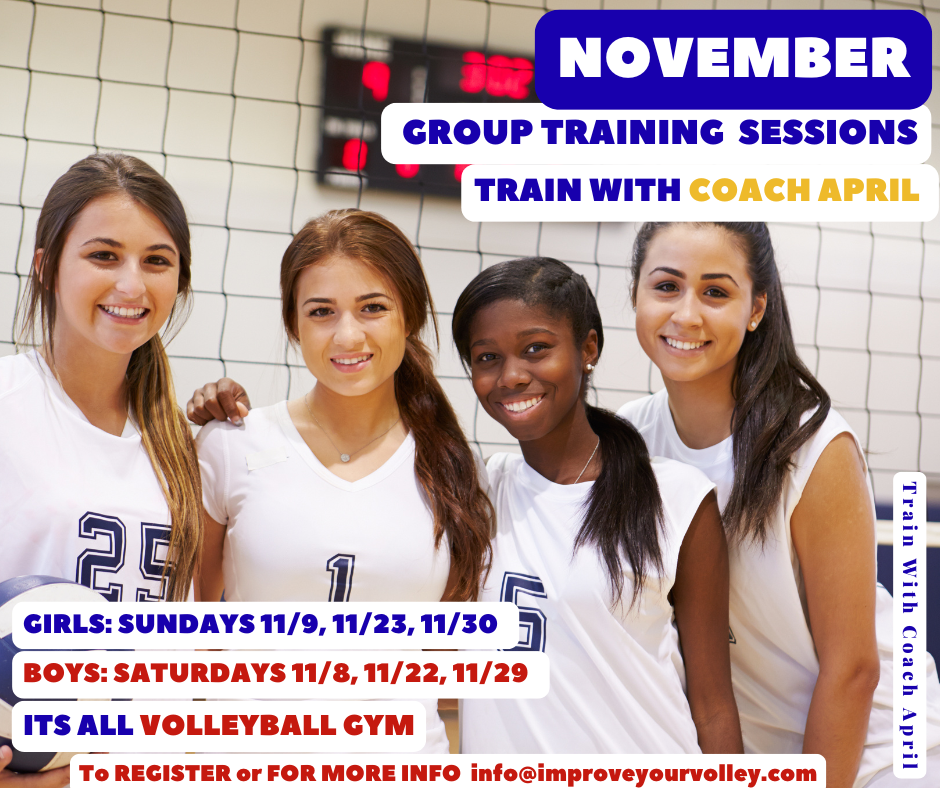
What Are You Looking For?
Click to Download Your Pre Serving Ritual Mastery Checklist pdf:
🎯Volleyball Pre Serving Ritual Guide -
Players! Learn How To Transform Your Serve from Weak to Weapon
Click to Download Your Parent's Volleyball Serving Checklist pdf
🎯Parent's Volleyball Serving Checklist Guide
Parents! Help Your Player Develop Championship Serves (Even If You've Never Played)

Hi there!
Thanks for stopping by. Hope you learned something today that will help you reach your volleyball goals.
Be sure to subscribe to my email newsletter so you can learn more each week!
Stay strong! Stay motivated!
-Coach April

SUSCRIBE to my email newsletter below!

 Click to learn more about the weekly volleyball classes and clinics or email info@imrpoveyourvolley.com for information
Click to learn more about the weekly volleyball classes and clinics or email info@imrpoveyourvolley.com for informationCongratulations to my seven Boys-18s Vegas Volley club players who played in two state championship finals yesterday, the 3A and 5A State champinship finals at Sunrise Mountain High School.
TOURNAMENT CHAMPIONS!
A-1 Vegas Volley VBC
In It To Win It Tournament
May 2 - 4, 2025 Tournament
Gold Medalists
18s Premier Division
Vegas Volleyball's Unsung Heroes: Celebrating Moms with Peace Love Volleyball Shirts
Ready to energize your volleyball mom journey?
Subscribe to my 'Producing Powerful Passionate Peaceful Players' email list above on ImproveYourVolley.com.
You'll receive energy-boosting tips, exclusive insights from me, Coach April Chapple on maintaining momentum in volleyball.
Let's power up the Vegas volleyball scene together!
Recent Articles
-
How to Jump Float Serve: 3 Pro Volleyball Player's Secret Serving Tips
Nov 28, 25 08:34 PM
Why do college players rely on the jump float serve? It combines power with unpredictable movement. Learn how to jump float serve like the pros in this guide. -
Use A Jump Float Serve To Create Power For An Ace Or To Start A Rally
Nov 28, 25 08:32 PM
Use the overhand jump float serve to generate a powerful serve that starts a rally after the ref blows the whistle for the player behind the service line. -
What is the Role of Libero in Volleyball The Back Court Specialist
Nov 28, 25 08:12 PM
The role of libero in volleyball is of a backrow specialist who goes in to pass, dig and serve for one of two players they can go in for without a substitution.
